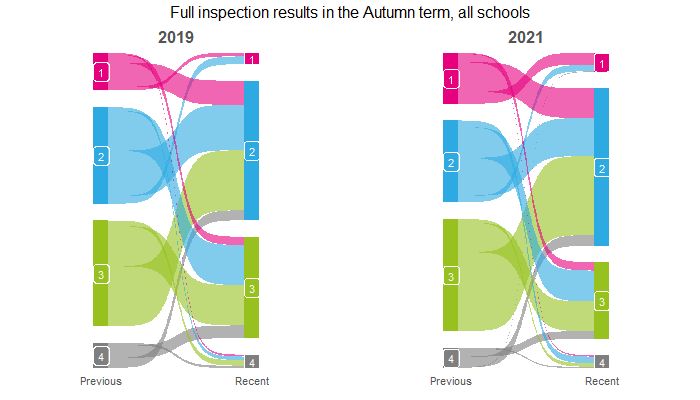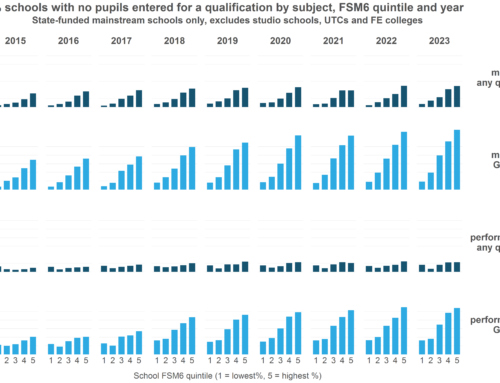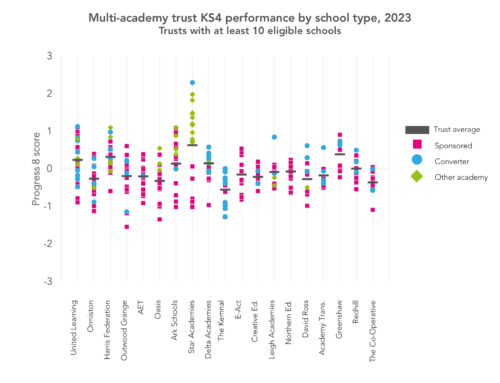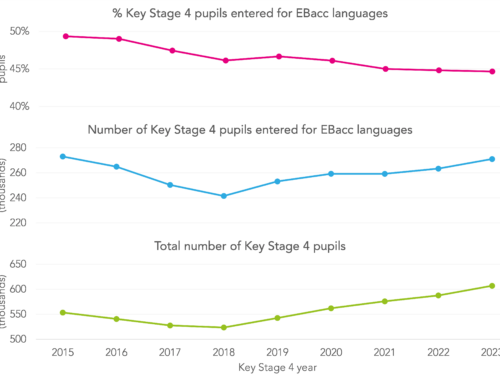*updated 9th February 2022 to correct the date range used for Autumn 2019 inspections.
Ofsted published its monthly management information update today.
This is actually more interesting than it sounds as it contains results inspections published up to the end of December. The latest start date of these inspections was the 16th November. Inspections were paused from 13th December until this week when they resumed albeit with a much reduced number of inspectors.
These results are interesting for two reasons.
The results cover a period when Ofsted resumed a more normal schedule of inspection for the first time during a global pandemic, when there were much higher than normal rates of pupil and staff absence.
Secondly because these are the first set of inspection results after the exemption from routine inspection for outstanding schools was lifted.
So in this post we’re going to compare inspection results to the same period at the start of the Autumn term of 2019[1].
We will look at the two types of school inspection:
- Inspections that result in the awarding of an overall grade[2]
- Inspections for good and outstanding schools that do not result in the awarding of an overall grade
Section 5 inspections
Section 5 inspections result in the awarding of a graded judgment. This also occurs in Section 8 deemed Section 5 inspections when an inspector uncovers evidence that a good or outstanding school may be inadequate in one or more of the graded judgments, or where an outstanding school may have declined to ‘requires improvement’.
There were 468 full inspections across all types of school in 2019 compared to 590 in 2021.
In the diagram below, we compare the results of inspections across all schools in both 2019. We do this separately for primary and secondary schools. We leave aside special schools, nursery schools and AP schools at this stage due to small numbers of inspections.
In each of the two charts we show schools’ previous inspection judgments for overall effectiveness on the left hand side and the judgment received in the right hand column.
As was to be expected, there were proportionately more inspections of previously outstanding (grade 1) schools in 2021 following the removal of exemption from routine inspection. 77% of outstanding schools inspected in 2021 were downgraded.
Outstanding schools only tended to be inspected prior to 2021 if Ofsted’s risk assessment suggested that standards were declining. With the re-introduction of re-inspections we might therefore have expected proportionately fewer previously outstanding schools to be downgraded in 2021. While this is true, it was still the case that most of the outstanding schools inspected were downgraded although we would expect this to be the case to some extent due to regression to the mean.
At the other end of the scale, it can be seen that schools rated as requires improvement (grade 3) or inadequate (grade 4) were more likely to receive a higher grade if inspected in 2021 than in 2019.
But if we tease apart the overall results and present separate charts for primary and secondary we start to see something different.
Visually, it appears that primary schools previous graded outstanding were more likely than secondary schools to be downgraded.
As the tables below show, only 15 previously outstanding secondary schools were inspected in 2021 so perhaps we shouldn’t read too much in it.
But 84% of previously outstanding primary schools who were inspected in the Autumn term in 2021 were downgraded.
Section 8 inspections
Ofsted reported the results of 413 Section 8 inspections of good and outstanding schools so far this year. This compares to 471 over the same period in 2019. Back then of course, previously outstanding schools were not inspected bar a small number of exempt school inspections or inspections of outstanding primary schools.
Unless they are deemed Section 5 inspections as a result of inspectors uncovering evidence of it being inadequate, short inspections do not result in changes of inspection grade.
However, inspectors can specify that a school’s next inspection will be a full Section 5 inspection if they do not believe that the school would receive their current grade if subject to a full inspection.
In some cases (where the previous grade =2) this may be because the school appears to be improving. But in most cases it is because there are concerns that standards are declining.
The table below summarises the outcomes in short inspections in both 2019 and 2021. There were no short inspections of outstanding schools in 2019.
Overall, 88 out of 317 (28%) of primary schools inspected in 2021 had concerns raised this way. This compares to 7 of 65 (11%) of secondary schools. Even just among the previously good schools, there were proportionately more primary schools identified with concerns compared to 2019.
Summing up
The early results from Ofsted inspections this term does seem to suggest that the bar for outstanding has been raised. And this so far seems to be being felt more in the primary sector than in secondary.
Should these early indications persist then the overall inspection grade profile for schools will change, particularly the percentage judged outstanding. The Chief Inspector recently suggested that the rate could well halve.
But we could also end up with more RI schools moving up as well. With proportionately fewer schools graded outstanding and RI it would then be worth asking whether it is worth having four outcomes.
Thanks to Steve Rollett for comments on an earlier version.
- We have used inspections started on 13th November 2019 (the second Wednesday in November) as a cut-off
- This includes Section 5 inspections, Section 8 deemed Section 5 inspections and Section 8 inspections that convert to Section 5
Want to stay up-to-date with the latest research from FFT Education Datalab? Sign up to Datalab’s mailing list to get notifications about new blogposts, or to receive the team’s half-termly newsletter.










Do you have the same data for alternative provision?
Hi Richard. There is but it looks like there were only 5 Section 5 and (incredibly) 8 Section 8 inspections reported for the 2021 year to date. I think we’d have to wait for a few more results before we’d be able to do anything meaningful.
Thanks for the excellent visualisations. Did you use the grade of the predecessor school for “previous” in the case of academy conversions between two inspections, or did you exclude any converting between the two most recent inspections? This may be a particular issue for formerly ‘Outstanding’ designations due to the period of time that has elapsed between inspections, of course.
Hi George. Thank you! This is a very good point. Ofsted now include the previous grade of predecessor schools in their management information. However, I’d forgotten that this wasn’t always the case and I should check the 2019 data (and issue a correction if necessary).
Have you done the analysis by type of schools? Is there a difference in who retains a grade and who changes, between maintained and academies, for instance? Across primary and secondary too, this would be an interesting statistic